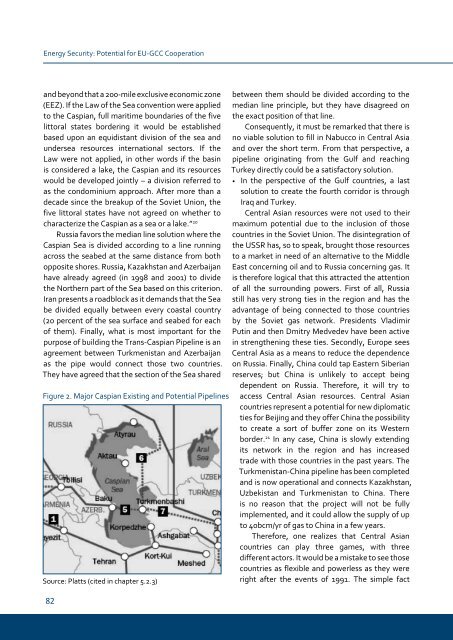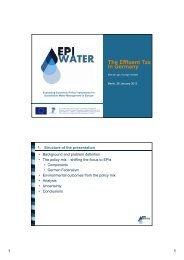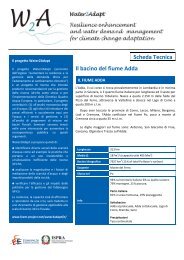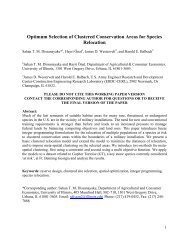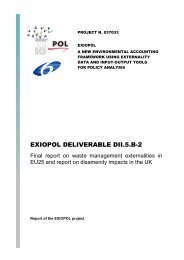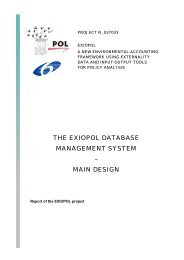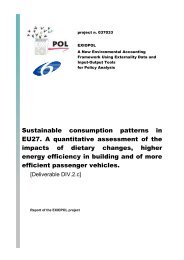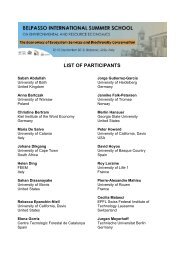Gulf and European Energy Supply Security - Feem-project.net
Gulf and European Energy Supply Security - Feem-project.net
Gulf and European Energy Supply Security - Feem-project.net
You also want an ePaper? Increase the reach of your titles
YUMPU automatically turns print PDFs into web optimized ePapers that Google loves.
<strong>Energy</strong> <strong>Security</strong>: Potential for EU-GCC Cooperation<br />
<strong>and</strong> beyond that a 200-mile exclusive economic zone<br />
(EEZ). If the Law of the Sea convention were applied<br />
to the Caspian, full maritime boundaries of the five<br />
littoral states bordering it would be established<br />
based upon an equidistant division of the sea <strong>and</strong><br />
undersea resources international sectors. If the<br />
Law were not applied, in other words if the basin<br />
is considered a lake, the Caspian <strong>and</strong> its resources<br />
would be developed jointly – a division referred to<br />
as the condominium approach. After more than a<br />
decade since the breakup of the Soviet Union, the<br />
five littoral states have not agreed on whether to<br />
characterize the Caspian as a sea or a lake.” 20<br />
Russia favors the median line solution where the<br />
Caspian Sea is divided according to a line running<br />
across the seabed at the same distance from both<br />
opposite shores. Russia, Kazakhstan <strong>and</strong> Azerbaijan<br />
have already agreed (in 1998 <strong>and</strong> 2001) to divide<br />
the Northern part of the Sea based on this criterion.<br />
Iran presents a roadblock as it dem<strong>and</strong>s that the Sea<br />
be divided equally between every coastal country<br />
(20 percent of the sea surface <strong>and</strong> seabed for each<br />
of them). Finally, what is most important for the<br />
purpose of building the Trans-Caspian Pipeline is an<br />
agreement between Turkmenistan <strong>and</strong> Azerbaijan<br />
as the pipe would connect those two countries.<br />
They have agreed that the section of the Sea shared<br />
Figure 2. Major Caspian Existing <strong>and</strong> Potential Pipelines<br />
Source: Platts (cited in chapter 5.2.3)<br />
2<br />
between them should be divided according to the<br />
median line principle, but they have disagreed on<br />
the exact position of that line.<br />
Consequently, it must be remarked that there is<br />
no viable solution to fill in Nabucco in Central Asia<br />
<strong>and</strong> over the short term. From that perspective, a<br />
pipeline originating from the <strong>Gulf</strong> <strong>and</strong> reaching<br />
Turkey directly could be a satisfactory solution.<br />
In the perspective of the <strong>Gulf</strong> countries, a last<br />
solution to create the fourth corridor is through<br />
Iraq <strong>and</strong> Turkey.<br />
Central Asian resources were not used to their<br />
maximum potential due to the inclusion of those<br />
countries in the Soviet Union. The disintegration of<br />
the USSR has, so to speak, brought those resources<br />
to a market in need of an alternative to the Middle<br />
East concerning oil <strong>and</strong> to Russia concerning gas. It<br />
is therefore logical that this attracted the attention<br />
of all the surrounding powers. First of all, Russia<br />
still has very strong ties in the region <strong>and</strong> has the<br />
advantage of being connected to those countries<br />
by the Soviet gas <strong>net</strong>work. Presidents Vladimir<br />
Putin <strong>and</strong> then Dmitry Medvedev have been active<br />
in strengthening these ties. Secondly, Europe sees<br />
Central Asia as a means to reduce the dependence<br />
on Russia. Finally, China could tap Eastern Siberian<br />
reserves; but China is unlikely to accept being<br />
dependent on Russia. Therefore, it will try to<br />
access Central Asian resources. Central Asian<br />
countries represent a potential for new diplomatic<br />
ties for Beijing <strong>and</strong> they offer China the possibility<br />
to create a sort of buffer zone on its Western<br />
border. 21 •<br />
In any case, China is slowly extending<br />
its <strong>net</strong>work in the region <strong>and</strong> has increased<br />
trade with those countries in the past years. The<br />
Turkmenistan-China pipeline has been completed<br />
<strong>and</strong> is now operational <strong>and</strong> connects Kazakhstan,<br />
Uzbekistan <strong>and</strong> Turkmenistan to China. There<br />
is no reason that the <strong>project</strong> will not be fully<br />
implemented, <strong>and</strong> it could allow the supply of up<br />
to 40bcm/yr of gas to China in a few years.<br />
Therefore, one realizes that Central Asian<br />
countries can play three games, with three<br />
different actors. It would be a mistake to see those<br />
countries as flexible <strong>and</strong> powerless as they were<br />
right after the events of 1991. The simple fact


